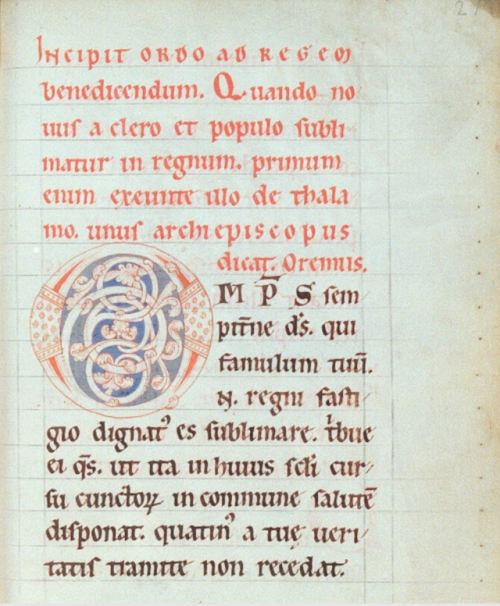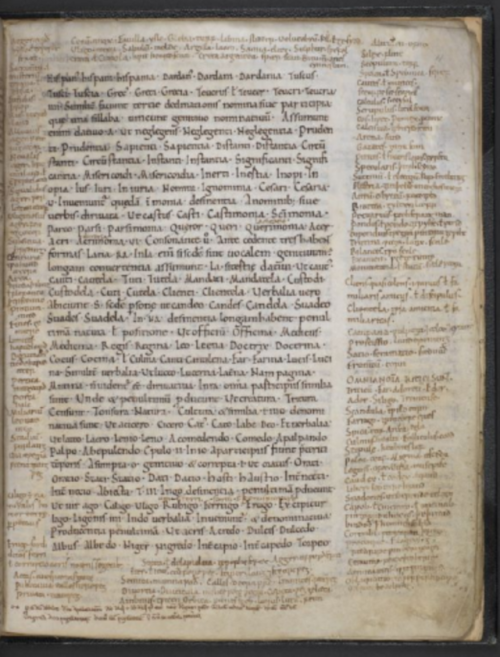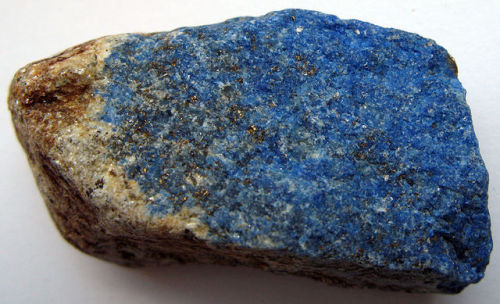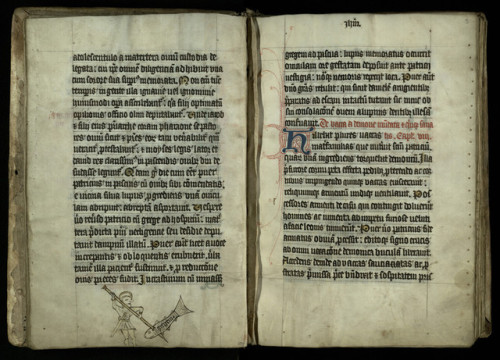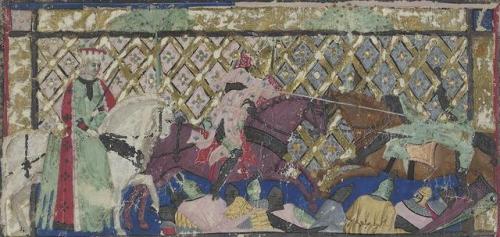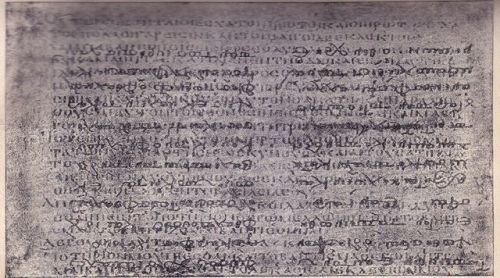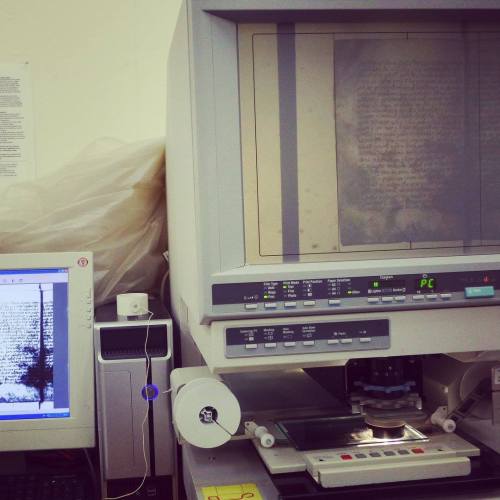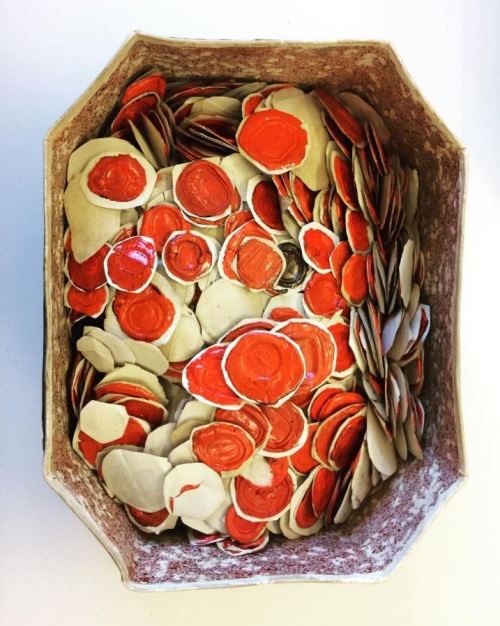#manuscript studies
The Text/Page Ratio
The text/page ratio is the term used to refer to the ratio of black (text) to white (blank space) on a page, resulting in a number between 0 (no text) and 1 (entirely covered with text). Because of the graphical nature of manuscripts, “text” refers to illustration, as well. The images above show the famous Chi-ro leaf from the Book of Kells and a spread from the Codex Sinaiticus. While the illustration in the Book of Kells consumes more solid space, the narrow line spacing employed in the Codex Sinaiticus may also result in a high text/page ratio.
Location:The Bodelian Library (Oxford, U.K.); The British Museum (London, U.K.)
Usage Rights: Public domain
Post link
Marginal Pricking, Newer Manuscript
Pricking, or small holes placed in a line, helped to determine the placement and spacing of lines during the ruling process. Marginal pricking, as pictured in Köln Cod. 139 above, overtook in-text pricking during the later middle ages. While it interfered little with the writing of the text, marginal pricking was often cut off during the final binding, or during future restoration processes. Therefore, marginal pricking is sometimes more difficult to locate than its predecessor.
Location:Archbishop’s Diocesan and Cathedral Library (Cologne, Germany)
Usage Rights: Public Domain
Reference:
“Section 7: Page Layout, Pricking, and Ruling.” Virtual Hill Museum and Manuscript Library, n.d. Saint John’s University, https://www.vhmml.org/school/lesson/basics-paleography/page-layout
Post link
The Invisible Technique of Dry-Point Ruling
From the early to high middle ages, copyists ruled (put lines on) manuscripts using a dry point, or a sharp stylus that carved small, precise lines onto parchment. Unless examined up-close, these lines were invisible to the naked eye. This 11th-century copy of Priscian’s Grammar (MS 32246) displays remnants of the dry-point lines left long ago.
Location:The British Library (London, U.K.)
Usage Rights: Public domain
References:
Hudson, Alison. “A Female Doctor.” Medieval Manuscripts Blog, 6 Oct. 2018. The British Library. http://blogs.bl.uk/digitisedmanuscripts/latin/
Post link
Lapis Lazuli - The Luxury Pigment
When making blue pigment or colorant, medieval copyists would save money and time by using minerals native to them. Some of these were copper carbonite - which could also provide greenish tints - and woad, a plant with extractable blue color.
Copyists typically reserved lapis lazuli, pictured above, for more luxury manuscripts. Imported from Afghanistan, the mineral produced a rich, vibrant shade of blue known today as ultramarine.
Location: Afghanistan
Usage Rights: Public domain
Post link
Catchwords - A Way of Marking Chapters
A catchword is the first word of a chapter or section printed at the bottom of the final page of the preceding chapter or section. Codicologists first observed catchwords in 9th-century French manuscripts, and it seems that the tradition rapidly spread throughout Europe.
As displayed on Trinity MS R.3.60, funny illustrations sometimes accompanied these catchwords. This could have been to show intentionality, that the catchword was not simply a mis-copy at the bottom of the page.
Location:Trinity College Library, Cambridge (Cambridge, United Kingdom)
Usage Rights: All images are copyright the Master and Fellows of Trinity College, Cambridge unless otherwise stated.
Resource:
Trinity College Library. “Catchwords.” Trinity College Library, Cambridge: Treasures from the Collection. Trinity College Library, 17 Apr. 2015. https://trinitycollegelibrarycambridge.wordpress.com/2015/04/17/catchwords/
Post link
Ferro Gallic Ink - Corroding History
Ferro gallic ink was a type of black ink used in manuscripts from the 11th-12th century. It is made by first extracting color from crushed gull nuts, acorns, or other plant material high in tannin and mixing the extraction with vitriol (iron sulphite) and an agglutinating agent, typically gum arabic.
The addition of vitriol made ferro gallic ink far more permanent than its predecessor, carbon ink, which could be washed away despite its intense color. Nevertheless, vitirol was also highly corrosive. As a result, late medieval manuscripts that used ferro gallic ink have been eaten away by their own pigments. The past 20 years have seen massive efforts to prevent this decay, but the rate of damage continues to surpass the rate of restoration.
It is thought that ferro gallic ink has been one of the worst inventions in the European codic canon.
The photo above illustrates a codex that has been partially disintegrated by ferro gallic ink.
Location:Yale University Library (New Haven, Massachusetts)
Usage Rights: Content property of Yale University Library. Reproduced under Fair Use.
Resource
User: Marieflemay. “Iron Gall Ink.” Yale University Library Travelling Scriptorium, 21 Mar. 2013. Yale University Library, https://travelingscriptorium.library.yale.edu/2013/03/21/iron-gall-ink/
Post link
Miniatures - A Lesson in Red Pigment
The lay definition of miniature is a small illustration found in both medieval manuscripts and elsewhere. Codicology utilizes a narrower conception of the term, referring to any illustration in a medieval manuscript that uses red (lat. miniare).
In medieval manuscripts, two elements were used to make red pigment. The first was cinnabar, a mercury sulphide found in mines. The other, minium (sound familiar?), came from roasting ceruse (white lead) until it turned red.
Medieval copyists also used less deadly methods to make red colorants. Brazil wood, imported from southeast Asia, contained red pigments that could be extracted and mixed with an agglutinating agent.
Above is a miniature from Le Roman de Tristan, a 14th-century story from France. As you can see, the red here makes the definition.
Location:La bibliothèque nationale de France, https://gallica.bnf.fr/ark:/12148/btv1b52503108b/f8.item
Usage Rights: public domain
Post link
Palimpsest, or Medieval Attempts to Erase Pen
When you were very young - say, in elementary or primary school - did you try to use your pencil’s eraser to get rid of pen markings?
Because, to me, that’s what a palimpsest (from the gk. palìmpsēstos,“scraped again”) looks like.
Palimpsests were manuscript pages on which the original text had been washed or scraped off to make room for a newer text. Relatively insignificant texts endured these scrapings, for they would typically become the canvas for lettering practice and training.
However, some palimpsests became home to legendary texts that today hold high patrimonial value. Pictured above is the Codex Ephraemi Rescriptus, a Syrian Hymnal.
Location:Bibliothèque Nationale de France (Paris, France)
Usage Rights: Public Domain
Post link
And so it begins…
Welcome to my blog, a commentary on the life of my MPhil:
“A transcription and commentary of NLW 5267”
Essentially, I’m attempting to make an edition of a 15th century Welsh manuscript known as ‘Y Casgliad Brith’- The speckled collection. Which is a lot more fun than it sounds. :)
The manuscript hasn’t really been looked at before (beyond a cursory glance or two) and it’s got a whole host of crazy things in it. It was written in 1438 in the hand of Siancyn ap Dafydd ap Gruffudd. The texts themselves are a mixture of Religious, scientific, and historical texts, including the life of St Catharine, Proverbs, and the Welsh ‘Delw y Byd’,a treatise on geography.
So, are you ready to take the journey with me? I promise it will be fun!
All the best,
Rebecca.
Good luck!
Post link
Medieval souvenirs
Thin pieces of metal that are bluntly attached to precious illuminated pages. It is not something you see every day in a medieval book - or imagined to see at all in such delicate objects. They are pilgrim’s badges, mementos purchased during pilgrimages to holy sites in medieval Europe. They are really not very different from the Eiffel Towers, baseball caps or Big Bens that we carry home in our suitcases today: they are mass-produced, cheap and highly portable souvenirs. If you went to see the shrine of St Thomas Becket, you would take a badge home, partly to show that you had been (like this one). The badges above are special because the pilgrim attached them to the pages of his prayerbook when he came home, which is how they survived. The shiny pieces of metal are religious instruments, of course, but they also proudly emphasize that the owner of the book went on a real pilgrimage: been there, done that!
Pics: Oxford, Bodleian Library, Douce MS 51 (Book of Hours, Flanders, c. 1490). More images and information here. More about medieval pilgrimages here. A safer (but not cheaper) alternative was to have pilgrim’s badges painted into a book (here).
Post link
This beautiful box of wax seals - snipped from hundreds of letters - is part of the Fox Talbot archive currently being catalogued by our archivists.
The contents of the letters is a mystery!
Oooh! These are great. I wonder what they were from? Business correspondence, love letters, family news…
Post link



